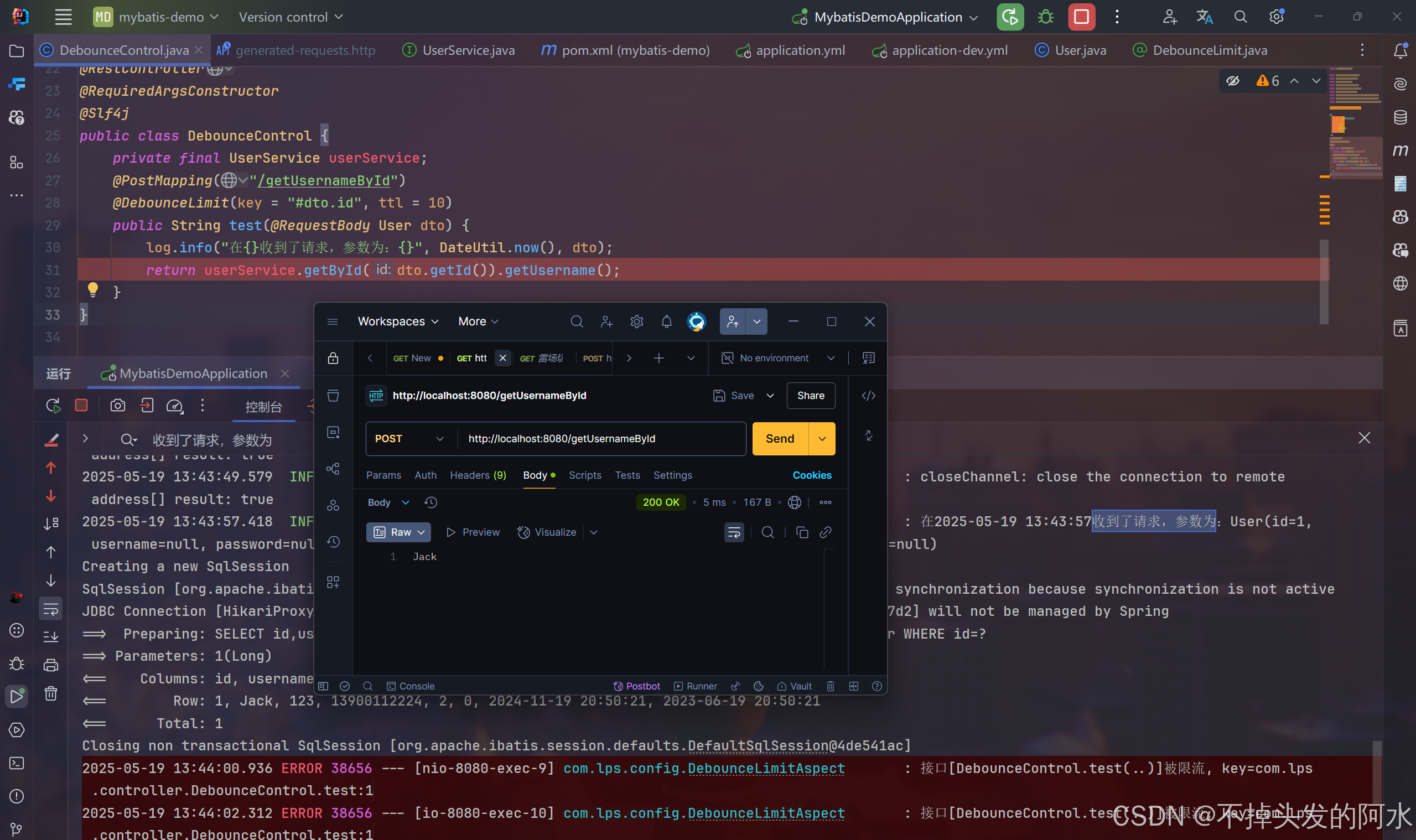.org网站开发/seo权威入门教程
一、背景与需求
在实际项目开发中,经常遇到接口被前端高频触发、按钮被多次点击或者接口重复提交的问题,导致服务压力变大、数据冗余、甚至引发幂等性/安全风险。
常规做法是前端节流/防抖、后端用Redis全局限流、或者API网关限流。但在很多场景下:
-
接口只要求单机(本地)防抖,不需要全局一致性;
-
只想让同一个业务对象(同一手机号、同一业务ID、唯一标识)在自定义设置秒内只处理一次;
-
想要注解式配置,让代码更优雅、好维护。
这个时候,Caffeine+自定义注解+AOP的本地限流(防抖)方案非常合适。
二、方案设计
1. Caffeine介绍
Caffeine 是目前Java领域最热门、性能最高的本地内存缓存库,QPS可达百万级,适用于低延迟、高并发、短TTL缓存场景。
在本地限流、防抖、接口去重等方面天然有优势。
2. 自定义注解+AOP
用自定义注解(如@DebounceLimit)标记要防抖的接口,AOP切面拦截后判断是否需要限流,核心思路是:
-
以唯一标识作为key;
-
每次访问接口,先查询本地Caffeine缓存;
-
如果key在2秒内已被处理过,则直接拦截;
-
否则执行业务逻辑,并记录处理时间。
这种方式无侵入、代码简洁、可扩展性强,适合绝大多数本地场景。
效果图如下:

三、完整实现步骤
1.Pom依赖如下
<dependency><groupId>com.github.ben-manes.caffeine</groupId><artifactId>caffeine</artifactId><version>2.9.3</version></dependency><dependency><groupId>org.aspectj</groupId><artifactId>aspectjweaver</artifactId></dependency>2. 定义自定义注解
import java.lang.annotation.*;@Target(ElementType.METHOD)
@Retention(RetentionPolicy.RUNTIME)
@Documented
public @interface DebounceLimit {/*** 唯一key(支持SpEL表达式,如 #dto.id)*/String key();/*** 防抖时间,单位秒*/int ttl() default 2;/*** 是否返回上次缓存的返回值*/boolean returnLastResult() default true;
}
3. 配置Caffeine缓存Bean
import com.github.benmanes.caffeine.cache.Cache;
import com.github.benmanes.caffeine.cache.Caffeine;
import org.springframework.context.annotation.Bean;
import org.springframework.context.annotation.Configuration;import java.util.concurrent.TimeUnit;@Configuration
public class DebounceCacheConfig {@Beanpublic Cache<String, Object> debounceCache() {return Caffeine.newBuilder().expireAfterWrite(1, TimeUnit.MINUTES).maximumSize(100_000).build();}
}
4. 编写AOP切面
import com.github.benmanes.caffeine.cache.Cache;
import com.lps.anno.DebounceLimit;
import lombok.Getter;
import lombok.extern.slf4j.Slf4j;
import org.aspectj.lang.ProceedingJoinPoint;
import org.aspectj.lang.annotation.Around;
import org.aspectj.lang.annotation.Aspect;
import org.aspectj.lang.reflect.MethodSignature;
import org.springframework.beans.factory.annotation.Autowired;
import org.springframework.expression.ExpressionParser;
import org.springframework.expression.spel.standard.SpelExpressionParser;
import org.springframework.expression.spel.support.StandardEvaluationContext;
import org.springframework.stereotype.Component;
import java.lang.reflect.Method;@Slf4j
@Aspect
@Component
public class DebounceLimitAspect {@Autowiredprivate Cache<String, Object> debounceCache;private final ExpressionParser parser = new SpelExpressionParser();@Around("@annotation(debounceLimit)")public Object around(ProceedingJoinPoint pjp, DebounceLimit debounceLimit) throws Throwable {// 1. 获取方法、参数MethodSignature methodSignature = (MethodSignature) pjp.getSignature();Method method = methodSignature.getMethod();Object[] args = pjp.getArgs();String[] paramNames = methodSignature.getParameterNames();StandardEvaluationContext context = new StandardEvaluationContext();for (int i = 0; i < paramNames.length; i++) {context.setVariable(paramNames[i], args[i]);}// 2. 解析SpEL表达式得到唯一keyString key = parser.parseExpression(debounceLimit.key()).getValue(context, String.class);String cacheKey = method.getDeclaringClass().getName() + "." + method.getName() + ":" + key;long now = System.currentTimeMillis();DebounceResult<Object> debounceResult = (DebounceResult<Object>) debounceCache.getIfPresent(cacheKey);if (debounceResult != null && (now - debounceResult.getTimestamp() < debounceLimit.ttl() * 1000L)) {String methodName = pjp.getSignature().toShortString();log.error("接口[{}]被限流, key={}", methodName, cacheKey);// 是否返回上次结果if (debounceLimit.returnLastResult() && debounceResult.getResult() != null) {return debounceResult.getResult();}// 统一失败响应,可自定义异常或返回结构return new RuntimeException("操作过于频繁,请稍后再试!");}Object result = pjp.proceed();debounceCache.put(cacheKey, new DebounceResult<>(result, now));return result;}@Getterstatic class DebounceResult<T> {private final T result;private final long timestamp;public DebounceResult(T result, long timestamp) {this.result = result;this.timestamp = timestamp;}}
}5. 控制器里直接用注解实现防抖
@RestController
@RequiredArgsConstructor
@Slf4j
public class DebounceControl {private final UserService userService;@PostMapping("/getUsernameById")@DebounceLimit(key = "#dto.id", ttl = 10)public String test(@RequestBody User dto) {log.info("在{}收到了请求,参数为:{}", DateUtil.now(), dto);return userService.getById(dto.getId()).getUsername();}
}
只要加了这个注解,同一个id的请求在自定义设置的秒内只处理一次,其他直接被拦截并打印日志。
四、扩展与注意事项
-
SpEL表达式灵活
-
可以用
#dto.id、#dto.mobile、#paramName等,非常适合多参数、复杂唯一性业务场景。
-
-
returnLastResult适合有“缓存返回结果”的场景
-
比如查询接口、表单重复提交直接复用上次的返回值。
-
-
本地限流仅适用于单机环境
-
多节点部署建议用Redis分布式限流,原理一样。
-
-
缓存key建议加上方法签名
-
避免不同接口之间key冲突。
-
-
Caffeine最大缓存、过期时间应根据业务并发和内存合理设置
-
绝大多数接口几千到几万key都没压力。
-
五、适用与不适用场景
适用:
-
单机接口防抖/限流
-
短时间重复提交防控
-
按业务唯一标识维度防刷
-
秒杀、报名、投票等接口本地保护
不适用:
-
分布式场景(建议用Redis或API网关限流)
-
需要全局一致性的业务
-
内存非常敏感/极端高并发下,需结合Redis做混合限流
六、总结
Caffeine + 注解 + AOP的本地限流防抖方案,实现简单、代码优雅、性能极高、扩展灵活。
